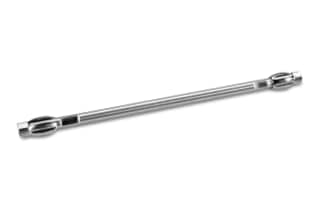
|
Chemistry |
C18 |
|
Separation Mode |
Reversed Phase |
|
Particle Substrate |
Hybrid |
|
pH Range Min |
1 pH |
|
pH Range Max |
12 pH |
|
Maximum Pressure |
6000 psi (415 Bar) |
|
Endcapped |
Yes |
|
Silanol Activity |
Low |
|
Particle Shape |
Spherical |
|
Particle Size |
3.5 µm |
|
Endfitting Type |
Waters |
|
Pore Size |
130 Å |
|
Format |
Column |
|
Surface Area |
185 |
|
System |
HPLC |
|
Particle Technology |
BEH |
|
USP Classification |
L1 |
|
Inner Diameter |
2.1 mm |
|
Length |
150 mm |
|
Carbon Load |
18 % |
|
UNSPSC |
41115709 |
|
Brand |
XBridge |
|
Product Type |
Columns |
|
Units per Package |
1 pk |
XBridge BEH C18 Column, 130Å, 3.5 µm, 2.1 mm X 150 mm, 1/pk
With the ability to be used over an entire range of mobile phase pH (1-12), the XBridge BEH C18 Column is the workhorse for HPLC method development. This universal column is useful for a variety of separations and will be familiar to separation scientists globally who seek their flexibility. With trifunctional bonding and an advanced end-capping process, XBridge BEH C18 Columns offer excellent reproducibility and performance with extended column lifetimes.
Because of the ability to switch between high and low pH, these columns lead to a drastic reduction in downtime of the lab equipment and ultimate cost savings on separations dealing with multiple pH levels. The use of BEH Technology particles allows for XBridge columns to be used at higher pH than conventional columns while still allowing for “pH switching” without a decrease in performance. Under accelerated low-pH test conditions, the columns show little retention; under accelerated high-pH conditions, chemical stability is possible over a long lifetime. Lifetime can be extended even further using an XBridge BEH C18 Column, 130Å, 3.5 µm, 2.1 mm X 150 mm, 1/pk.
The sorbent contained in XBridge columns has been designed specifically to be the most chemically stable chromatographic sorbent available, facilitating the use of extreme pH ranges. The improved pH stability facilitates longer lifetimes, while improved column reliability allows for assay ruggedness. All of this is done while maximizing particle efficiency for unmatched peak shape and peak capacity as a result of the BEH particle synthesis used in column creation.
As part of the universal family of XBridge HPLC columns, the XBridge BEH C18 Column eliminates compromises in sorbent selection, allowing for the flexibility to work under any mobile phase, temperature, or pH range.
What Solvents Should Be Used With XBridge BEH C18 Columns?
For maximum column performance, high-quality chromatography grade solvents are recommended. All aqueous buffers should be filtered prior to use- Waters recommends Pall Gelman Laboratory Acrodisc filters. A solvent that contains suspended particulate material will often clog the outside surface of the inlet distribution frit of the column and cause higher operating pressure and poor performance. All solvents should be thoroughly degassed prior to use to prevent bubble formation in the pump and detector. It is recommended to use an on-line degassing unit, especially when running low-pressure gradients.